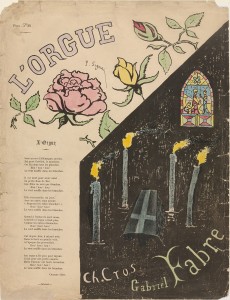
Paul Signac, L’Orgue, Cover design for the composition by Gabriel Fabre on a poem by Charles Cros, 1893. Lithograph with watercolor additions, 14 1/4 x 11 in. Gift of John Rewald. The Museum of Modern Art, New York. © 2014 Artists Rights Society (ARS), New York / ADAGP, Paris
The recent panel discussion Neo-Impressionists and Symbolists: Allies and Rivals provided me with a better sense of how artists in the exhibition used poetry and music within their work, sometimes trying to create a synergy of the senses or synesthesia. Synesthesia involves the union of sensation from multiple art forms; for example, one could hear music and see color, or see a painting that evokes music. One of the artworks discussed during the panel, L’Orgue by Paul Signac, is illustrated here. The work combines poetry, music, and visual art.
Created in 1891, the piece is a cover design for a musical composition by Gabriel Fabre—which was inspired from a poem by Charles Cros. Little is known of Fabre other than that he fraternized with the Parisian Symbolist circles, including Signac and Cros. Cros a writer, inventor, and poet, aspired to create poetry that used evocative imagery and lyrical, rhythmic language.
Charles Saunier, a critic for the literary and art magazine La Plume, commented on Signac’s L’Orgue: “First a melancholy German ballad, a melodious rustle of wind, then the harmonies which…persist quietly sad while the voice dies down. Thus smoke from an altar candle rises blue in the abandoned cathedral. For this melody the painter Paul Signac composed a strange lithograph heightened with color; roses, stained glass, altar candles illuminating a coffin.”
I think this perfectly captures the combination and equality of the arts that Signac created in his cover design; a synesthetic experience that allows the viewer to experience poetry, music, and visual art simultaneously.
Kelley Daley, Graduate Intern for Lectures and Programs



